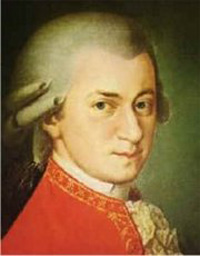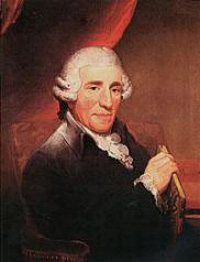| Mozart Fest and Gala | ||||||||||
Piano Concerto No. 19 in F major, K. 459 Mozart composed a total of 28 solo keyboard concertos, most of them for his own use in subscription concerts in Vienna. Consequently, the timing of their composition was influenced by the artistic climate and the economic well being of the city. In the short period between 1782 and 1786, with a booming economy, aristocratic families vied with one another to underwrite and sponsor concerts of the latest in musical fashion. During those flush years, Mozart was in great demand both as a composer and performer at the keyboard, composing 17 concertos, including this one in F Major. “Concertos,” Mozart wrote his father, “are a happy medium between what is too hard and too easy...pleasing to the ear...without being vapid.” However successful a composer might be at this time, both the greatest prestige and the money came primarily from opera, as opposed to instrumental music. After 1786 Mozart was eager to be seen more as an opera composer than a performer. He concentrated his efforts and genius – beyond anything he had produced before in this genre – on his three great comic operas with libretti by Lorenzo da Ponte, Le nozze di Figaro, Don Giovanni and Cosí fan tutte. The Concerto in F Major was composed in late 1784 and probably premiered in one of six successful subscription concerts Mozart gave in February and March of 1785. The Concerto is scored for piano, flute, two oboes, two bassoons, two horns and strings. But in his thematic catalogue entry Mozart also lists two trumpets and timpani, not included in the surviving autograph. The composer either penned a second version, now lost, or made an error in the catalogue entry. The extant version also contains Mozart’s own cadenzas. In this concerto Mozart gives special prominence to the winds, especially the principal oboe and flute, which get lovely solo riffs and dialogues with the piano. Although in conventional sonata-allegro form, the first initial theme,  a modified fanfare motive, persists throughout the movement as an almost constant presence in the form of a refrain between episodes, almost like a rondo. The second subject gets considerably less attention and recurs only in the recapitulation. a modified fanfare motive, persists throughout the movement as an almost constant presence in the form of a refrain between episodes, almost like a rondo. The second subject gets considerably less attention and recurs only in the recapitulation.  And Mozart provides a third melody framed by the refrain. And Mozart provides a third melody framed by the refrain.  The Allegretto also uses its main theme as a refrain,  creating an expansion on the conventional da capo (ABA) structure, AB creating an expansion on the conventional da capo (ABA) structure, AB  AC. AC.  It is in this movement that the oboe and flute are featured so prominently. It is in this movement that the oboe and flute are featured so prominently.In the finale, Mozart continues his tendency to feature refrains, as well as showcasing the winds. It is a rondo, but combined with a sonata form. The brief rondo theme (or first subject)  is followed by a fugato, which becomes one of the principal subsidiary themes of the movement. is followed by a fugato, which becomes one of the principal subsidiary themes of the movement.  But the interplay of these two styles throughout the movement creates an atmosphere of good humor rather than pedantry. Mozart also adds episodic melodies that alternate with fragments of the rondo refrain. But the interplay of these two styles throughout the movement creates an atmosphere of good humor rather than pedantry. Mozart also adds episodic melodies that alternate with fragments of the rondo refrain.   With its brief middle section, the harmonic digression has the quality of a development, and the various themes are recapped at the end of the movement. With its brief middle section, the harmonic digression has the quality of a development, and the various themes are recapped at the end of the movement. | ||||||||||
Overture to Armida, Hob.1a:14 We think of Haydn today as the father of the symphony and the string quartet, forgetting that during his employ at Esterháza he was also a major opera composer for Prince Nikolaus, his boss. Haydn created more than two dozen works for the stage, but these works are more dated than his instrumental music and were mostly forgotten. Today they are occasionally performed in conservatory or opera workshop performances. Haydn considered Armida his finest opera. Composed in 1783, it received numerous productions at Esterháza, as well as in Budapest, Vienna and Turin. It then disappeared from the repertoire until 1968. The libretto, based on the bottomless resource of Tasso’s poem Gerusalemme liberata, invokes the sinister powers of the sorceress Armida (built on the model of Homer’s Circe) who tries – unsuccessfully – to seduce crusader knights on their way to liberate Jerusalem. Armida was a perennial favorite for opera composers, from Monteverdi (Armida abbandonata, now lost) in 1627 to Dvořák in 1904, and including Handel, Gluck and Rossini. The three-part overture is played without pause but generally adheres to the sonata principle in fast-slow-fast movements. It reflects to some degree the drama of the story, although there was at this time no tradition of introducing numbers from the opera itself. The first section, Allegro, is relatively generic for an overture,  as is the second. as is the second.  The third part, however introduces the danger of the sorceress The third part, however introduces the danger of the sorceress  but ends on a triumphant note by repeating the opening measures of the Overture. but ends on a triumphant note by repeating the opening measures of the Overture. | ||||||||||
| Wolfgang Amadeus Mozart Piano Concerto No. 27 in B-flat major, K. 595 For five years after Mozart moved to Vienna in 1781, he was a hot commodity, greatly in demand both as a composer and virtuoso performer. Commissions flooded in, and his economic position was quite comfortable. But by the latter part of the decade, things went sour and Mozart mythology, as well as musicological debate, has tried to explain how this musical phenomenon could have so dramatically slipped in favor. The decline in the Austro-Hungarian Empire’s economy and the fickleness in taste of Vienna’s moneyed elite reduced Mozart to writing dance music for local balls in order to shore up his dwindling finances. On a more personal front, The Marriage of Figaro with its portrayal of a morally tarnished aristocracy, had displeased Emperor Joseph II – hence the whole court. By the beginning of 1791, Mozart, not surprisingly, was also trying to cope with a deep depression. Mozart can justifiably be regarded as the “inventor” of the classical piano concerto. During the Baroque period, keyboard concertos were common, but these were composed for the harpsichord. The fortepiano – invented by Bartolomeo Cristofori around 1750 – made its public appearance only during the third quarter of the century. By the time of Mozart’s youth, the instrument was still “under development,” and the style for orchestral music had moved past that of Baroque keyboard concertos. Although his earliest concertos were not true concertos at all, but rather orchestral accompaniments for solo piano pieces, his mature concertos combine unprecedented drama and elaborate presentation of themes that set the bar for all subsequent composers. The B-flat Piano Concerto is Mozart's last. It was premiered in January 1791 and, unlike his other concerti, was not performed for an all-Mozart program, which would have brought in quite a bit of money in subscription sales alone. Rather, it was premiered at the invitation of clarinetist Joseph Bähr for a varied concert at Jahn's Hall in Vienna; it was Mozart’s last public performance. Surprisingly, considering the circumstances, the concerto sounds rather emotionally detached. It opens with a lyric theme beginning with a major triad in the strings, interrupted by a little fanfare in the winds.  This sets the tone for a work that is easygoing in spirit compared to his earlier piano concerti, especially the D minor (K. 466), C minor (K. 491) and the "Coronation" Concerto (K. 537). This sets the tone for a work that is easygoing in spirit compared to his earlier piano concerti, especially the D minor (K. 466), C minor (K. 491) and the "Coronation" Concerto (K. 537). That being said, the galant (elegant but not a vehicle for the composer to wear his heart on his sleeve) quality of the first movement is full of surprises. When the piano enters, it is with a decorated version of the orchestra’s theme, unlike in some earlier concertos where the soloist comes in with a whole new collection of melodies. Then things begin to get strange. Mozart delays the appearance of the second theme with a dramatic bridge  that makes the real goal sound pallid, that makes the real goal sound pallid,  but promises a wild ride in the development through a series of stunning modulations. but promises a wild ride in the development through a series of stunning modulations.  The slow second movement, usually the emotional powerhouse of Mozart’s concerti, lacks the pathos and intensity of his typical slow movements. Again, the word galant comes to mind. The theme, without its grace notes is simple and confined.  The middle section, which might have shed a darker tone to the movement, is also emotionally cool. The middle section, which might have shed a darker tone to the movement, is also emotionally cool.  Like so many of Mozart's works, there is a thematic connection between the major triad that opens the final rondo and the theme of the first movement.  Mozart used the rondo melody again in the first of a set of three songs, Sehnsucht nach dem Frühling (Longing for spring), K. 596. He takes the opportunity to string out a series of odd modulations in an episode in the middle of the movement, parallel to his forays in the first movement. Mozart used the rondo melody again in the first of a set of three songs, Sehnsucht nach dem Frühling (Longing for spring), K. 596. He takes the opportunity to string out a series of odd modulations in an episode in the middle of the movement, parallel to his forays in the first movement.  | ||||||||||
| Copyright © Elizabeth and Joseph Kahn 2017 | ||||||||||

